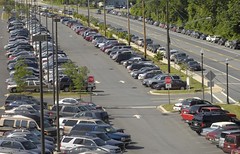Transit still dominated by automobility and automobile-centricity
1. If you drive to transit, you defeat a lot of the advantages of transit. Transit systems can't afford to build unlimited parking at stations. What needs to happen is the creation of bus shuttles/routing to take people to high-capacity stations without their driving, without the transit system having to build and support parking lots and parking structures.
See "A lot of lots, but not enough: Mass transit riders, car-poolers cruise streets for parking," from the Baltimore Sun. The article includes a list of parking capacity at various MARC commuter railroad stations, Baltimore area light rail stations, and MTA commuter bus park and ride lots.

The commuter parking lot at the Halethorpe MARC station fills up fast in the morning. Commuters park on nearby streets, leading to clashes with residents. (Sun photo by Amy Davis / June 19, 2008).
Originally, Montgomery County, Maryland built its RideOn bus system around providing service from neighborhoods to red line subway stations. (I don't know if they also do this with MARC stations, although there are many co-located MARC and subway stations such as Silver Spring or Rockville.
2. I have written about transit in the Detroit region. You can imagine in a region dominated by automobile manufacturing, that over the years, an efficient transit system has been dismantled in favor of automobility. And Detroit is more exurban and deconcentrated than most other U.S. metropolitan regions.
And I say that of course this should have happened, because that's exactly what the automobile industry wanted to have happen to the city.
The Wall Street Journal published a piece last week, "Eyes on the Road," about how the increased demand for transit given higher gasoline prices can't be met in regions with weak transit systems. From the article:
Detroit put America on wheels during the past century, and that process crippled mass transit in many big cities, starting with Detroit itself. In the 1920s, Detroit had a network of buses and electric streetcars that formed the core of one of the biggest publicly owned transit systems in the U.S., according to a history at detroittransit.org.
In 1945, Detroit's rail and bus network provided 492 million rides -- more than a million a day. Eleven years later, the Detroit streetcar system was dead, and the automobile officially took control.
During the next 50 years, freeways replaced rail lines; the dense neighborhoods of Detroit and its old suburbs were abandoned in favor of subdivisions; and the Detroit mass-transit system bumped down the road to irrelevance.
Political leaders wrangled over whether to have one regional bus system serving Detroit and its suburbs (as of now, there are two.) Some 50 suburban communities -- including the one where I live -- opted out of contributing tax money to the Suburban Mobility Authority for Regional Transportation, commonly known as SMART, selling voters on the idea that their tax money was being wasted on buses that rode around largely empty. As a result, the nearest SMART bus stop between my house and my office is about 10 miles away.
Many years ago, and I can't remember the writer (I think it was either Howard Wilensky or Charles Perrow), I remember reading a sociology treatise on the value of redundancy. We're seeing that now with transit...
3. Speaking of the lack of redundancy, the New York Times reports on Amtrak ridership increases in "Travelers Shift to Rail as Cost of Fuel Rises." Amtrak has the same problem of lack of capacity. A cash starved system can't all of a sudden expand service. It doesn't have slack resources-- the rolling stock, locomotive engineers, conductors, etc.
4. Like how Congress and the Federal Transit Administration are working to make it more difficult for public transit to provide seemless service, use public resources wisely, extend branding objectives, and promote sampling by new consumer market segments by restricting the ability of public transit systems to provide service to K-12 public school students and shuttle services, Congressman John Mica wants Amtrak to give up some of its exclusive right-of-way in the Northeast Corridor to the private sector to create a high-speed rail service. See the press release, "Information on Rep. Mica's High Speed Rail Initiative," from the House Committee on Transportation and Infrastructure, Republicans. (Note that Congressman Mica has had pieces on the proposal published in the railroad trade magazines.)
But Amtrak has already studied Maglev service. And such service could be used to reposition rail service more generally. (See The Baltimore-Washington Maglev Project.)
5. Why let the private sector cherrypick the segments of the market that are profitable, and offload all the segments of the market "requiring subsidy" to the public sector, and then turn around and complain that public transit requires permanent subsidy (at the same time failing to acknowledge that automobility and the road and freeway infrastructure also requires permanent subsidy as the cost of building and maintaining the street network requires subsidies to the tune of 50% of the cost.
Labels: electoral politics, public finance, railroads, transit, transportation planning



0 Comments:
Post a Comment
<< Home